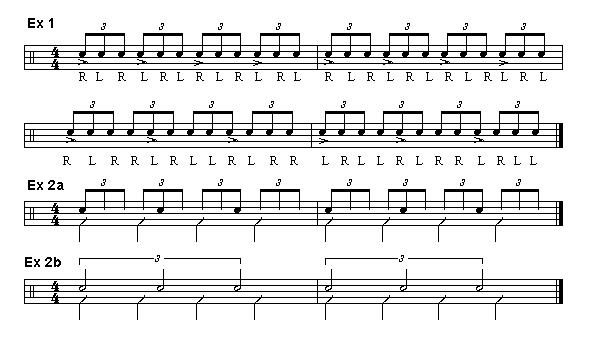Triplets phrased in single-paraddidles can be an easy and useful way in
which to imply a polyrhythm. The basic idea is to play normal eighth-note
triplets, but instead of using the typical single stroke sticking use a
single-paradiddle sticking. Example1 demonstrates 2
measures of single-stroke triplets, followed by 2 measures of triplets
using a single-paradiddle sticking. Pay close attention to the
accents. In the single stroke measures I've indicated the accents
on counts 1, 2, 3, and 4. In the paradiddle measures the accents
occur in four note groupings. The 1st, 5th and 9th notes of the eighth-note triplets are accented.
By playing triplets and accenting the begininnig of every four note grouping we will be playing
3 evenly spaced accents within a measure of 4/4 time. Playing
3 evenly spaced notes over a 4/4 pulse gives us the polyrhythm of 3:4 (sometimes
referred to as 3 against 4). To more clearly see the phrasing refer
to example 2a. In this example I've indicated the accented
notes (i.e. the notes which imply the 3 portion in the 3 against
4 polyrhythm ) with solid note heads. (Note:I've also shown the 4/4
pulse below the triplets.) Now, if we only play the accented
notes and leave the others out, we end up with half-note triplets in 4/4
time. This is notated in example 2b. Half-note
triplets played over a quarter note pulse is a very common way of producing
a 3 against 4 polyrhythm. Also, be aware that the accents which occur in our single-paradiddle
triplets actually correspond to the notes of a half-note triplet.
This can be seen by comparing example 2a and example
2b.

So what does all this mean to us? It means that by using the
naturally occuring accents in the single paradiddle sticking, we can easily
imply a feeling of 3 against 4. Assuming that a basic 4/4 pulse has
already been established (either by you or the band), all
you need to do is play triplets using the single paradiddle sticking.
By emphasizing the accents you will be producing the effect of a 3 against
4 polyrhythm. The accents in the single-paradiddle will produce the
3 part. The basic 4/4 pulse will be the 4 part.
The advantage of using single-paradiddles in this situation is that they
automatically give us the correct accent pattern. The naturally occuring
accent of the four note groupings is exactly want we want to produce
the 3 over 4 effect.
An added bonus to what we have been discussing is that it also demonstrates the important rule-of-thumb
for calculating any polyrhythm:
To play a polyrhythm of X:Y (i.e. X against Y), we divide the basic
pulse into grouping of Xs and play every Yth one.
For example: To play the polyrhythm of 3 against 4, we divide
the basic pulse into groupings of three (i.e. triplets), and play every fourth
one.
This is exactly what we have demonstrated above. By accenting
every fourth note in a string of eighth-note triplets we are producing
the effect of a 3 against 4 polyrythm. If we wish, we can take it a step further and
play only the accented notes. By so doing, we are actually playing half-note
triplets, and half-note triplets in 4/4 time create a 3 over 4 polyrhythm.
For more detailed information on polyrhythms refer to my article Understanding Polyrhythms.
Also see Rhythmic Analysis for the Snare Drum, by Fred Albright
